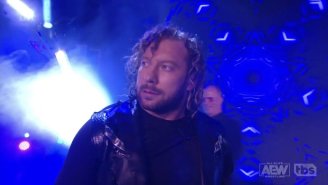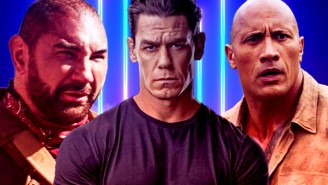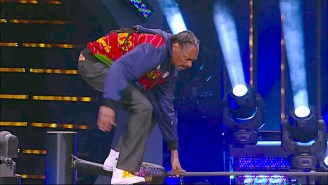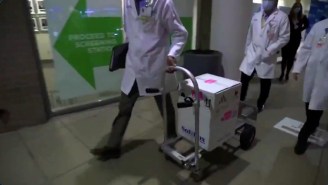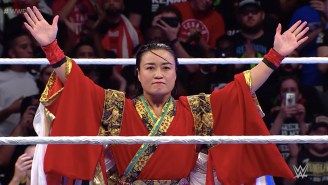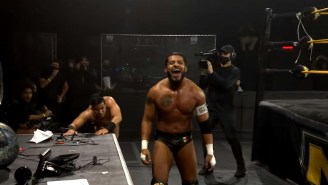It could probably be argued that Madison Square Garden is The House That Built Heyman. When the WWE Network goes live from MSG on October 3, it’ll be more than just a stop on Brock Lesnar’s Go To Hell Tour. It will also be a return to the familiar for Paul Heyman, a native New Yorker and one of the greatest talkers in WWE history. We were fortunate enough to chat with Heyman about his client, his roots, and that elusive realm known as Suplex City.
With Spandex: New York City and Madison Square Garden must feel like a homecoming to you, considering it’s where you got your start as a photographer for Vince McMahon, Sr. What are the emotions you feel when you return?
Paul Heyman: I love the Garden… when I was a kid, this was always the ultimate goal, but now I get to bring my kids to a show at a place that I would consider to be the center of the universe. The grand cathedral, the world’s most famous arena. And it’s not just the fact that it’s my hometown, but I think anybody from anywhere gets a certain thrill – a tingle up the spine, the proverbial goosebumps – working in Madison Square Garden. It’s like stepping up to the plate at Yankees Stadium in the World Series.
Has the atmosphere of a WWE show at Madison Square Garden changed at all over the years?
PH: Of course it has, but it’s bound to. If it didn’t, it would mean that the product hadn’t evolved. Of course it’s changed. Anything has changed, in sports and in entertainment. I would suggest to you that a Knicks game is different today than it was back in the day of Willis Reed and Walt Frazier. A [New York] Rangers game is going to be different than it was back in the ’70s, ’80s, or ’90s. Anything is going to be different. A boxing match in Madison Square Garden is going to have a much different atmosphere than it did back in the days of Muhammad Ali and Joe Frazier. A concert is going to be different than Frank Sinatra or Led Zeppelin playing MSG. All presentations in sports and entertainment are different today than they were back in the day.
Let’s talk about your client, Brock Lesnar. Does he enjoy the schedule he’s on now, working shows like Madison Square Garden and Beast In The East?
PH: Well, this whole concept of working a few more shows is actually Brock’s. Brock truly enjoys lacing up his boots. What drove Brock crazy when he was first in WWE was the travel and the schedule. And ultimately, he doesn’t live to work, he works to live. He wants to spend time with his family more than he wants to be on the road 250 days a year, and he figures his family needs a father more than WWE needs Brock Lesnar. Though with that being said, this is the best of all worlds. He’s agreed to more dates per year, which gives WWE more access to their top box office attraction, and Brock gets to do what he loves doing.
Shifting the focus over to Brock’s opponent at Madison Square Garden, how far back do you and The Big Show go?
PH: We were paired together on television in 2002 and 2003 when he had a run as WWE Champion, and also when WWE resurrected ECW in 2006. I actually met Big Show for the first time when Larry Sharpe brought him to the ECW Arena, when Big Show was a student at the Monster Factory, trying to get me to debut him in ECW.
I live in central Texas, and last week I heard high school football commentators making a “Suplex City” call. Are you surprised with how quickly that phrase caught on?
PH: No, because when something goes viral in today’s society, it truly just explodes into global culture faster than anything I’ve ever experienced in my lifetime. That’s the nature of the instant society we live in. The best example that I can give you of that is the “Eat, Sleep, (Blank), Repeat” phenomenon. Calvin Harris and Fatboy Slim had a song called “Eat, Sleep, Rave, Repeat.” It had been out for about eight or nine months and was fairly popular at all the festivals and nightclubs, but nobody outside of the festivals and nightclubs had ever heard of it. Brock and I returned to WWE television that December and came up with the new catchphrase “Eat, Sleep, Conquer, Repeat,” and it instantly went viral and became part of everybody’s marketing campaigns, even to this day. So when something catches on and just spreads, hence the term “viral,” it just spreads instantly. Suplex City has become part of the lexicon because once Brock said it at WrestleMania, it just exploded everywhere.
We’re quickly approaching another NXT Takeover on the WWE Network. Who do you think is going to steal the show?
PH: The audience! I think the biggest star in NXT is the appreciation, affection, and the affirmation that is delivered to the product by the audience. Which is why, to me, it’s so fascinating to watch. The audience tells the story, the audience makes the star. The audience will determine who the next true superstar out of NXT will be by showering that superstar with more love, more affirmation, more adulation than anybody else on the show. The audience dictates who will be the next breakout from NXT, which is why I find the shows to be so compelling, so riveting, so fascinating. It’s the crowd that tells the stories.
Finally, let’s say you had the chance to build a new Dangerous Alliance in 2015, using current WWE and NXT roster members. Who do you pick?
PH: Easiest question I’ve ever been asked. Brock Lesnar in the ring, and Paul Heyman on the mic. That is the single most dangerous alliance you could ever put together in WWE or any other form of sports, entertainment, or sports entertainment. So far, it’s worked out splendidly this way.

